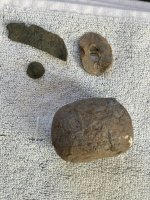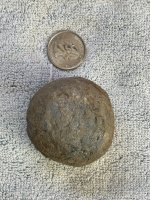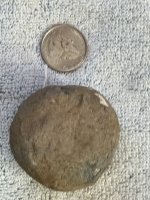Found this lead item in Calif. along the Old Spanish Trail. It's round, slightly flattened on one side & about 2" in dia. From a site that could be Spanish, Mexican or American period. Has anyone seen or found something similar? Can anyone help me date it?
Navigation
Install the app
How to install the app on iOS
Follow along with the video below to see how to install our site as a web app on your home screen.
Note: This feature may not be available in some browsers.
More options
You are using an out of date browser. It may not display this or other websites correctly.
You should upgrade or use an alternative browser.
You should upgrade or use an alternative browser.
🔎 UNIDENTIFIED Lead cannonball?
- Thread starter noxer800
- Start date
TheCannonballGuy
Gold Member
- Feb 24, 2006
- 6,590
- 13,338
- Detector(s) used
- White's 6000, Nautilus DMC-1, Minelab
- Primary Interest:
- Relic Hunting
When a cannonball is made of lead, it tends to consist of molten metal cast in a spherical mold. The corroded surface in of the metal in the photos does not have the appearance of cast lead. For example, lead does not develop cracks -- which we see in many places on this object's surface. Also, the object's shape is not anything close to a sphere. A cannonball MUST be a "True Sphere" because any significant lumps of bumps or out-of-roundness will cause the ball to "jam" in the cannon's bore during loading or firing. Also, this object does not look like a cast lead True-Sphere which has taken a few bumps from bouncing across the ground after firing. Sorry, I do not know what it is but I'm reasonably sure about what it's not -- a cannonball, a grapeshot ball, or other Artillery ball.
I should mention:
American Military cannonballs and e ball were always made of pure lead. This object appears to some sort of "pot-metal" type of cheap lead-alloy.
I should mention:
American Military cannonballs and e ball were always made of pure lead. This object appears to some sort of "pot-metal" type of cheap lead-alloy.
Upvote
4
- Thread starter
- #5
Thanks, CannonballGuy. What you say makes total sense, even if it reduces the excitement of my find. That's exactly the kind of feedback I was hoping to get. Just to clarify one thing. Have you previously seen Spanish or Mexican period (pre-1848) cannonballs and do your comments also apply to them? I ask this partly because the smaller lead musket balls that we find at Calif. Spanish and Mexican sites are not not perfectly spherical.When a cannonball is made of lead, it tends to consist of molten metal cast in a spherical mold. The corroded surface in of the metal in the photos does not have the appearance of cast lead. For example, lead does not develop cracks -- which we see in many places on this object's surface. Also, the object's shape is not anything close to a sphere. A cannonball MUST be a "True Sphere" because any significant lumps of bumps or out-of-roundness will cause the ball to "jam" in the cannon's bore during loading or firing. Also, this object does not look like a cast lead True-Sphere which has taken a few bumps from bouncing across the ground after firing. Sorry, I do not know what it is but I'm reasonably sure about what it's not -- a cannonball, a grapeshot ball, or other Artillery ball.
I should mention:
American Military cannonballs and e ball were always made of pure lead. This object appears to some sort of "pot-metal" type of cheap lead-alloy.
Upvote
0
TheCannonballGuy
Gold Member
- Feb 24, 2006
- 6,590
- 13,338
- Detector(s) used
- White's 6000, Nautilus DMC-1, Minelab
- Primary Interest:
- Relic Hunting
Noxer800 asked:
> Have you previously seen Spanish or Mexican period (pre-1848) cannonballs and
> do your comments also apply to them? I ask this partly because the smaller lead
> musket balls that we find at Calif. Spanish and Mexican sites are not perfectly spherical.
The "smaller lead musketballs" are not actually musketballs.... they are Canister-ammo for cannons. Also, some are extra-large buckshot. It doesn't matter if Canister or Buckshot is out-of-round, because a buckshot-ball or canister-ammo ball does not "fill the bore." A musketball or cannonball DOES literally "fill the bore"... therefore being bumpy or out-of-round can cause it to jam in the bore during loading or firing.
> Have you previously seen Spanish or Mexican period (pre-1848) cannonballs and
> do your comments also apply to them? I ask this partly because the smaller lead
> musket balls that we find at Calif. Spanish and Mexican sites are not perfectly spherical.
The "smaller lead musketballs" are not actually musketballs.... they are Canister-ammo for cannons. Also, some are extra-large buckshot. It doesn't matter if Canister or Buckshot is out-of-round, because a buckshot-ball or canister-ammo ball does not "fill the bore." A musketball or cannonball DOES literally "fill the bore"... therefore being bumpy or out-of-round can cause it to jam in the bore during loading or firing.
Upvote
0
Top Member Reactions
-
 3802
3802 -
 1879
1879 -
 1877
1877 -
 1851
1851 -
 1408
1408 -
 1163
1163 -
 1156
1156 -
 986
986 -
 802
802 -
 785
785 -
 700
700 -
 526
526 -
 514
514 -
 506
506 -
 485
485 -
E
429
-
 421
421 -
 396
396 -
 392
392 -
 391
391
Users who are viewing this thread
Total: 2 (members: 0, guests: 2)





